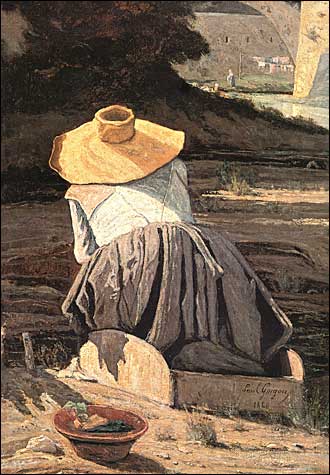
Paul Guigou, The washer woman Oil on cloth Musée d'Orsay
Photo RMN/René-Gabriel Ojéda |
|
MUSÉE MARMOTTAN MONET
2, rue Louis Boilly
75016 Paris
INFORMATION:
Tél. 01 44 96 50 39
Fax;01 40 50 65 84
site : http://:www.marmottan.com
e-mail : marmottan@marmottan.com
HOURS:
Everyday except monday
from 10h am to 6 pm
Tickets sales stop 30 minutes before closing.
ADMISSION FEES:
Full price: 7 €
Concessions : 4,50 €
Free: Under 8
The ticket gives access to the exhibitions
and the permanent collections
PRESS CONTACT:
Caroline Genet-Bondeville
Tél. 01 44 96 50 30
e-mail : cgenet@marmottan.com

|
In the tradition of the exhibitions it has organized over the last several years on the Impressionists, their predecessors and their immediate heirs, from Le Sidaner to Berthe Morisot, Claude Monet or Frédéric Bazille, the Marmottan museum in Paris presents the most important retrospective ever dedicated to the painter Paul Guigou. Designed by the musée des Beaux-arts of Marseille, it brings together one hundred and eighteen paintings, watercolors and drawings by the provençal master, lent by private collections and public institutions.
From Provence to Montmartre
Paul Guigou left his native Vaucluse in 1855 to come work in Paris. Some tutoring allowed him to survive and he was soon admitted to the Salon. He frequently traveled between Paris and Marseille – he even worked as a notary for a few months like his uncle did– but painted each summer in Provence. He took part in the Salon des Refusés (Salon of the rejected), then came back to the Salon in Paris, met frequently with the future Impressionist at the café Guerbois, but died prematurely at the age of 37 in 1871. He quickly fell into oblivion, just like Frédéric Bazille whose fate was so similar to his. It was not until the Centennial exhibit in 1900 that his work was rediscovered. The following year the State bought Paysage de Provence (Provence landscape) for the Musée du Luxembourg. Later the great art dealer Paul Rosenberg gave the Louvre museum one of Guigou’s masterpieces, La Lavandière,(The washer woman) that hangs today at the musée d’Orsay. A retrospective at the Musée du Luxembourg in 1927 and various exhibits in France contributed to his new renown.
A very modern vision of painting
His friend Frédéric Mistral considered Paul Guigou as the greatest painter of Provence.
«None one knew better than he how to render the luminous charm of our beautiful region, the harsh poetry of its rocky and sandy soil. He still does not have the place in the word of art he deserves. But the time will come». The prophecy has in part become a reality. Paul Guigou is the landscape artist of the Haute-Provence region, putting aside a few views of the outskirts of Paris. Strongly attached to his native land, he chose to be the interpreter of its charms, from the garrigues of the Lubéron to the shores of the Durance. A painter of large open spaces, where light specifies the contours of the trees or rocks, he gave magnificent renderings of the wild charm and the rough beauty of this land. Using a very luminous palette, by the choice of his subjects and the simplicity of their approach, he demonstrated a very modern vision of painting. A few historians consider him an «initiator of Impressionism». This exhibit should allow a larger public to discover him and to give him the place he deserves in XIXth century painting.
PUBLICATION
Exhibition Catalogue ill, 210 p. Coedited by Musées de Marseille-Musée Marmottan Monet Éditions Jeanne Laffitte 2004 Paperback 33.50 €
|








